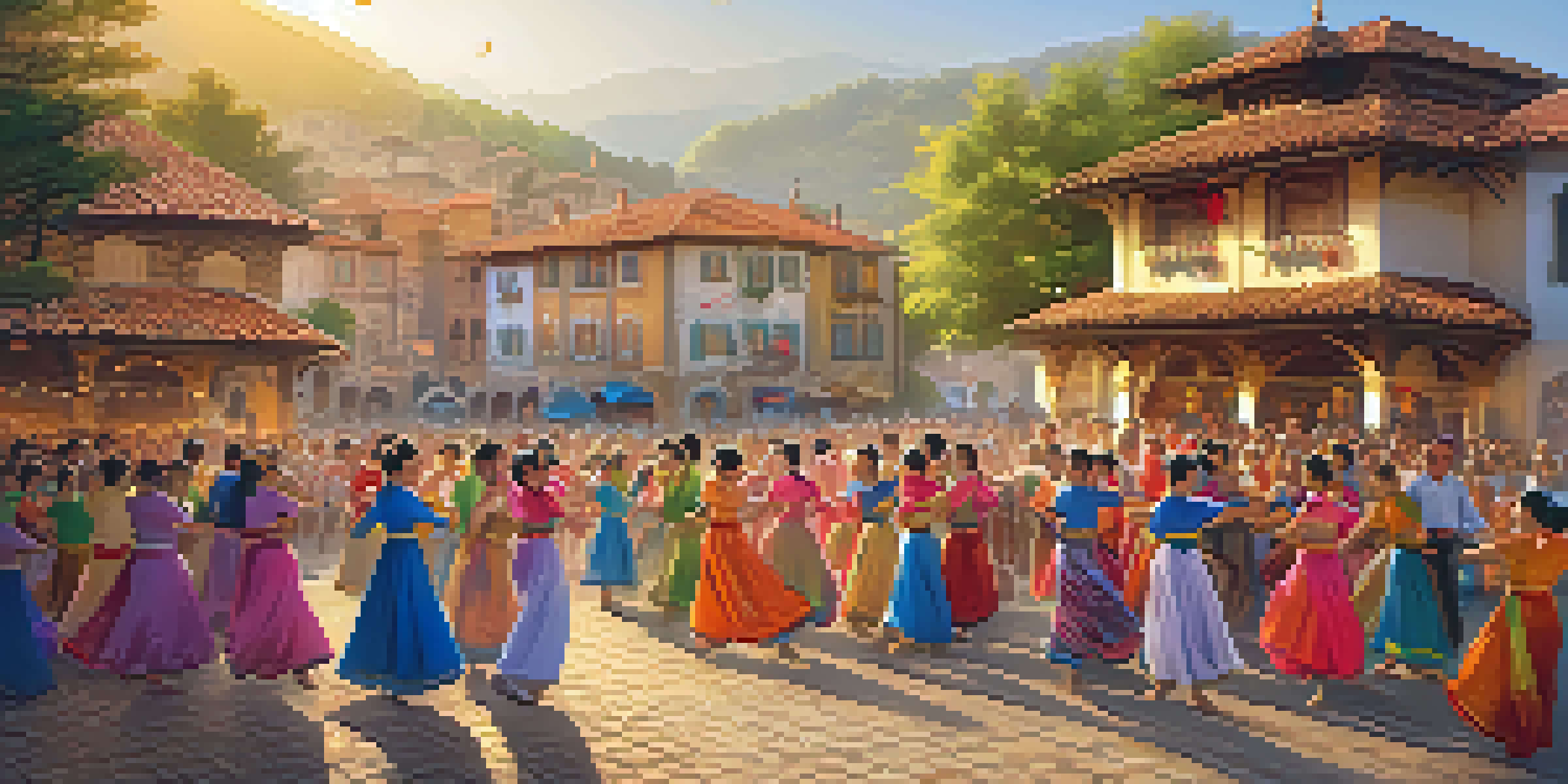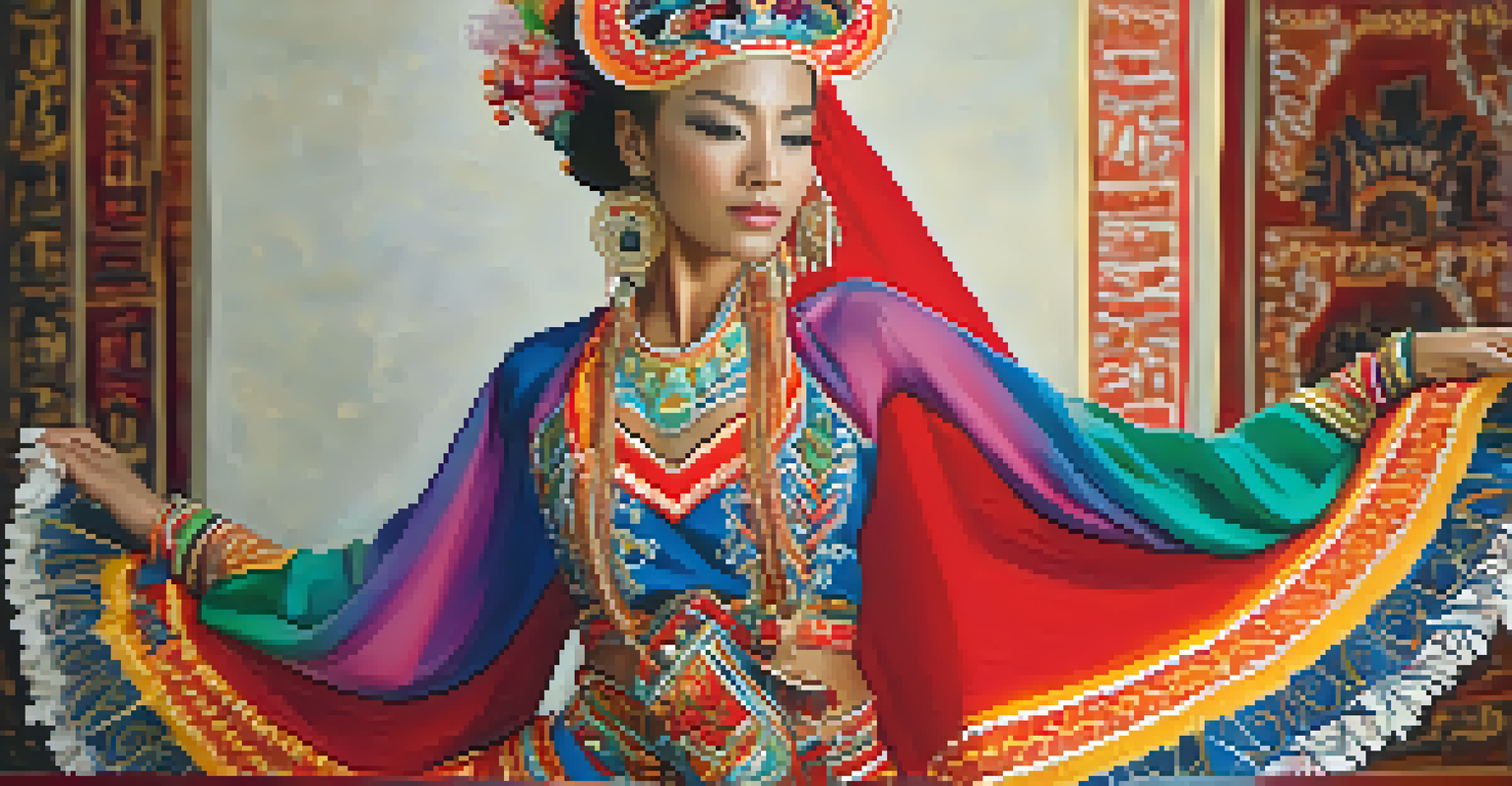The Impact of Traditional Dance on Local Tourism Growth

Understanding Traditional Dance and Its Cultural Significance
Traditional dance is more than just a performance; it's a vibrant expression of a community's history and identity. Each dance tells a story, often reflecting the customs, beliefs, and values of the people. This cultural richness not only engages participants but also fascinates tourists seeking authentic experiences.
Dance is the hidden language of the soul.
In many regions, traditional dances are deeply intertwined with local festivals and celebrations, serving as a focal point for community gatherings. These events create a lively atmosphere that attracts visitors, eager to witness the unique artistry of local performers. The visual and emotional impact of these dances can be a powerful draw for potential tourists.
Moreover, traditional dance fosters a sense of pride among locals, encouraging them to share their heritage with others. This shared enthusiasm can enhance the overall tourist experience, making visitors feel more connected to the community they are exploring.
The Role of Traditional Dance in Promoting Local Events
Local events often serve as a platform for traditional dance, showcasing it to both residents and tourists. Festivals featuring dance performances can significantly boost attendance, drawing crowds who may also explore local cuisine, art, and crafts. This synergy creates a vibrant cultural atmosphere that captivates visitors.

For instance, a dance festival may include workshops, competitions, and performances, providing diverse engagement opportunities for tourists. As they participate or watch, they gain deeper insights into the culture, enhancing their overall experience. This interactive aspect often leads to longer stays and increased spending in the community.
Cultural Significance of Dance
Traditional dance serves as a vibrant expression of a community's history, identity, and values.
Furthermore, these events can attract media attention, further promoting the locality as a tourist destination. Social media platforms buzz with photos and videos, amplifying the reach of traditional dance beyond geographic boundaries and enticing more visitors.
Economic Benefits of Traditional Dance Tourism
The economic impact of traditional dance on tourism is significant. As tourists flock to experience local dances, they contribute to the economy through spending on accommodations, food, and souvenirs. This influx of visitors can lead to job creation in various sectors, from hospitality to retail.
Tradition is not the worship of ashes, but the preservation of fire.
Additionally, local artisans often benefit from this surge in tourism, as visitors seek authentic crafts that reflect the culture of the area. Many tourists are interested in purchasing handmade items, which can provide artisans with a sustainable income stream. This not only supports the local economy but also helps preserve traditional crafting techniques.
Moreover, the visibility gained through traditional dance can attract further investment in the region, leading to infrastructure improvements and enhanced tourist facilities. This creates a cycle of growth that can benefit both the community and tourists alike.
Enhancing Visitor Experience Through Cultural Immersion
Experiencing traditional dance offers tourists a unique opportunity for cultural immersion. Unlike typical sightseeing, participating in or witnessing local dances lets visitors engage directly with the culture they are exploring. This hands-on experience can create lasting memories and a deeper appreciation for the community.
Some areas even offer classes or workshops, inviting tourists to learn the dances themselves. This interactive approach not only enriches their understanding but also fosters a connection with locals, breaking down barriers and building friendships. Such interactions can transform a simple trip into a life-changing experience.
Economic Impact of Dance Tourism
Tourists drawn to traditional dance contribute significantly to the local economy through spending and job creation.
Moreover, as tourists share their experiences on social media, they contribute to the community's reputation as a cultural hotspot. This word-of-mouth marketing is invaluable, encouraging others to visit and experience the unique offerings of traditional dance.
Preserving Heritage Through Dance and Tourism
Traditional dance acts as a living archive of cultural heritage, helping to preserve history for future generations. As communities invite tourists to witness their dances, they simultaneously educate visitors about their heritage. This exchange fosters respect and appreciation for cultural diversity.
In many cases, local governments and organizations recognize the importance of traditional dance in tourism and actively support its preservation. Funding for dance troupes and cultural programs can ensure that these art forms remain vibrant and relevant. This commitment not only benefits the local community but also enriches the experiences of tourists.
Furthermore, as tourists engage with these traditions, they can become advocates for their preservation. Their enthusiasm can lead to increased awareness and support for cultural initiatives, ensuring that traditional dance continues to thrive even as tourism evolves.
Challenges Faced by Traditional Dance in Tourism
Despite its many benefits, traditional dance faces challenges in the context of tourism. One significant issue is the risk of commercialization, where the authenticity of performances may be compromised to cater to tourist expectations. This can dilute the cultural significance of the dance, leading to a loss of its original meaning.
Additionally, local dancers may struggle with the pressure to perform frequently, which can lead to burnout and a decline in quality. Maintaining a balance between showcasing their art for tourists and preserving their passion for dance is essential. Communities must find ways to support their artists without sacrificing the integrity of their traditions.
Preserving Heritage Through Dance
Traditional dance acts as a living archive of cultural heritage, fostering respect and appreciation for diversity.
Moreover, as tourism increases, so does the risk of cultural appropriation. It's vital for communities to educate visitors about the significance of their dances, ensuring that appreciation does not turn into exploitation. Open dialogue and respect for cultural boundaries are necessary to navigate these challenges.
Future Prospects: Integrating Traditional Dance with Modern Tourism
Looking forward, integrating traditional dance into modern tourism strategies can yield exciting opportunities. By blending traditional performances with contemporary elements, communities can attract a broader audience while still honoring their heritage. This fusion can create unique experiences that appeal to both locals and tourists.
For instance, some regions are incorporating multimedia elements or fusion genres that combine traditional dance with modern styles. These innovative approaches can attract younger audiences, fostering interest in traditional practices while ensuring their sustainability. This adaptability can keep the art form alive and relevant.

Furthermore, as communities invest in training and resources for local dancers, they can enhance the quality of performances. This focus on excellence not only satisfies tourists but also instills pride in local artists, creating a cycle of growth and appreciation for traditional dance in tourism.